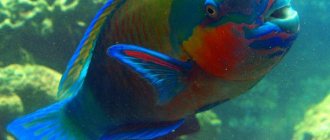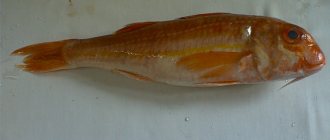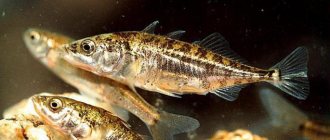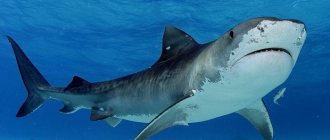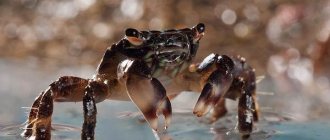author: fisher 10/19/2017 0 Comments
Family: Scorpionidae
coral fish
Lionfish is a generalized name for a group of fish in the scorpionfish family (Scorpaenidae), which includes more than a hundred species. Until recently, the habitat of lionfish was limited to the Indo-Pacific.
They can be found in the Red Sea, the coastal waters of China and South Africa, the southern Japanese islands, Malaysia, Australia and Polynesia. Where lionfish live at depths from 2 to 50 meters.
But at the end of the twentieth century, as a result of a typhoon that swept over the Antilles, a large private aquarium with marine aquatic organisms collected from various parts of the world's oceans was destroyed, among which were several lionfish and which, along with other species of fish, ended up in the Caribbean Sea.
After this event and until recently, in the Atlantic, lionfish could only be found in the Bahamas. But several years passed and they, not without the help of careless aquarists, mastered the coastal waters of Cuba, Haiti, the Cayman Islands and Florida.
Today, lionfish pose a real threat to the local ichthyofauna, destroying crustaceans and many small coral fish.
Oregon State University specialist Mark Hixon believes that the introduction of lionfish could be the most destructive invasion in the history of the Caribbean. But the saddest thing is that there is currently no way to stop it.
Lionfish
The average size of a lionfish is about 30 cm (maximum 40 cm). Weight up to one kilogram.
The lionfish is a predator; it has a large mouth that allows it to swallow fish only slightly smaller in size.
Gray, brown or red stripes run across the light background of the lionfish's Thanks to which, it is often called the zebra fish.
In the west it is better known as the lion fish. The lionfish has high-set eyes located close to each other. Young individuals have bizarre outgrowths above their eyes that disappear with age.
Bright colors in the animal world usually warn of danger. The lionfish is no exception to this rule . It is distinguished from other scorpionfish by its disproportionately large, ostrich-like feathers, pectoral and dorsal fins, which hide sharp poisonous spines.
The dorsal fin of lionfish consists of two parts, the front part is represented by a number of very long hard rays not interconnected by membranes, at the base of which poisonous glands are located, and the back part is represented by soft flexible rays.
All species of lionfish lead a sedentary, secretive lifestyle, most of the time hiding in rock crevices and caves formed by stones and corals. Despite their bright colors, lionfish are well camouflaged among corals. Usually they lie tightly pressed with their belly to the surface of the ground, spreading their dangerous fins to the sides. While waiting for prey, the lionfish can remain motionless for hours. Freezing, it becomes like a bunch of red algae. Small fish, trying to use it as a shelter, often end up in the mouth of a lionfish .
Sunset is the best period for hunting lionfish , since it is at this time that the activity of the coral reef population becomes maximum. All daytime inhabitants of the reef follow their overnight stay, and nocturnal animals go hunting. lionfish do not have to spend a lot of energy to catch prey
At dusk, lionfish glide along the rocks of the coral reef, looking for suitable prey. Having encountered one, the predator quickly draws in water along with its prey, and does it so quickly that other small fish nearby often do not have time to notice anything. Therefore, the lionfish can calmly continue its hunt for other members of the group.
Lionfish are also capable of hunting in open water. They often lie in wait near the surface for small fish when they jump out of the water, fleeing from other predators, and when diving back they end up in the mouth of a lionfish .
If during a hunt a lionfish meets another male of his species, his coloration becomes darker, and the rival, who finds himself in someone else's territory, usually folds his pectoral fins and retreats.
The lionfish is a predator; it has a large mouth that allows it to swallow fish only slightly smaller in size.
Often, novice divers, seeing such an interesting and colorful fish, which also behaves quite passively, try to touch it with their hand and as a result receive a very painful injection.
Consequences of a lionfish injection
the lionfish's poisonous spine is similar to a medical syringe; when injected, the poison from a sac located in the dorsal muscles of the lionfish rises through a channel passing inside the beam and enters the body of the attacker.
The lionfish never attacks first Bathers who accidentally step on it usually suffer from her injections.
As a result, a person experiences severe pain, often turning into temporary paralysis, and if the swimmer has not gotten out of the water by this time, he risks drowning.
Among lovers of outdoor activities on the water, lionfish have a bad reputation, as it is believed that its injection can kill a person. However, such cases have not yet been officially recorded.
lionfish injection experiences sharp pain for several hours, sometimes accompanied by increased sweating, convulsions, difficulty breathing, and sometimes disruption of the heart. The injection site swells. The pain from an injection with one thorn subsides only after a few hours, but makes itself felt within a few days.
If the injection is received by several thorns, the pain can become unbearable (even to the point of loss of consciousness). The antidote is the same serum as for cobra venom; some sources report that the pain can subside if you drink a weak solution of ammonium chloride. If you do nothing, the pain will go away on its own.
It should be borne in mind that even after the death of the lionfish , its poisonous spines retain their toxicity for a long time. The severity of the poison depends on the size of the fish.
Based on the above, special care must be taken lionfish
Lionfish in open water
Distribution of zebra fish.
The zebra fish is native to the Indo-Pacific region. Distributed in Western Australia and Malaysia in the Marquesas and Oeno Islands; in the north to Southern Japan and South Korea; including South Lord Howe, Kermadec and South Island.
Zebra fish (Pterois volitans)
The zebra fish were brought into the Gulf of Florida when a reef aquarium was destroyed during Hurricane Andrew in 1992. In addition, some fish are released into the sea accidentally or deliberately by people. No one can predict what the biological consequences of this unexpected introduction of zebra fish into new conditions will be.
Zebra fish habitats.
Zebrafish are primarily reef-dwelling fish, but can swim in the warm, saltwater waters of the tropics. They tend to glide along cliffs and coral atolls at night and hide in caves and crevices during the day.
Zebra fish - aquarium fish
Keeping in an aquarium
Despite their poisonous spines, lionfish remain one of the most popular objects to keep in marine aquariums. Not a single publication dedicated to the inhabitants of coral reefs is complete without their photographs. Today, the lionfish has become one of the symbols of marine aquariums.
For keeping in amateur aquariums, lionfish from the genera Pterois and Dendrochirus are of greatest interest.
In this article we will talk about the most common lionfish - Pterois volitans.
This species is of greatest interest for keeping in an aquarium. Because in addition to their magnificent coloring, these lionfish are also active during the daytime, swimming throughout the aquarium. Their maintenance does not require very large containers (minimum 250 liters), since by their nature lionfish are not very active.
In addition, possessing a certain intelligence, over time they are able to recognize their owner.
Unlike other members of the family, it has 13 rather than 12 poisonous spines in its dorsal fin and 14 in its pectoral fins. The anal fin has three spines and 6-7 rays.
Lionfish
Lionfish are not dangerous for large fish, so they can be kept in an aquarium with representatives of other species. They are quite suitable as inhabitants of a reef aquarium, as they do not spoil corals and algae.
In case of danger, for example, when it sees the aquarist’s hand, the lionfish does not try to attack it, but turns its poisonous fins towards it and slowly swims away. In optimal conditions, lionfish live for years, getting used to the owner.
Lionfish , they molt periodically, but their skin comes off not in stockings like the latter, but in separate flaps.
The conditions for keeping lionfish in an aquarium are the same as for most marine fish:
- Aquarium of at least 250 liters (optimally from 500 to 1000 liters)
- Water temperature 25 – 26°С
- pH 8.0 – 8.4
- Ammonia and nitrite content – 0
- Nitrates less than 20 ppm, preferably tends to zero
- Water density 1.021 – 1.025
- Water changes 10% weekly or 20% every two weeks using osmolyte and high quality sea salt
- Standard water filtration and regeneration system
It is advisable to organize active water circulation in the aquarium, but there should be areas with weak currents where the fish can rest.
Lionfish are quite hardy and disease resistant. But when water is of poor quality, the likelihood of bacterial diseases increases sharply.
The lionfish is traditionally considered one of the most dangerous creatures living in the sea. Even sharks are afraid to approach them, for fear of running into their poisonous spines. And for most small fish, a lionfish usually becomes fatal.
But there are fish in the ocean that are not averse to eating lionfish , in particular some types of moray eels. It is logical to assume that the poisonous spines of a swallowed lionfish would have caused severe injuries to the internal organs of the moray eel, which would have resulted in its death. However, this does not happen; moray eels happily absorb lionfish despite their “weapons.” The lifespan of lionfish in an aquarium is about 10 years.
Character and lifestyle
The lion fish is a predator. Its prey is small fish, shrimp, cephalopods, and small crabs. First, she paralyzes her victim with a prick of thorns, which is very painful. Severe pain appears and the condition worsens sharply. Next comes paralysis of the muscles of the respiratory system. As a result, the victim quickly dies. The predator completely swallows its prey. It is nocturnal and hides in reefs or underwater caves during the daytime.
During active hunting, she uses her long rays, which are located on the surface of her fins. With their help, she drives her victim to a crevice, where she paralyzes and swallows her. During passive hunting, it camouflages itself in algae, spreads its fins, remains motionless and waits for its prey. Small fish swim very close and become swallowed up by the lionfish.
It is difficult to detect it in algae or among coral reefs. Cleverly camouflaged, it looks like a beautiful bush.
Lionfish Reproduction
Sexual dimorphism is weakly expressed, males are slightly larger and more massive than females, and they are more aggressive than individuals of the opposite sex. Shortly before spawning, the color of the males becomes darker, and the stripes on the body become less contrasting. Females, on the contrary, lighten, the lower part of their body is painted silver-white. Apparently, this coloration makes them more visible at dusk, since spawning games begin shortly before dark and are always initiated by males.
The male pursues the female moving in a circular path; after making several circles, the spawners rise to the surface of the water. The pair can fall and rise several times. At the last stage, they already describe circles directly under the surface of the water.
At some point, the female spawns eggs in the form of two hollow tubes of mucus that float close to the surface. After a short period of time, these tubes are filled with seawater, turning into oval balls with a diameter of two to five centimeters. Each such ball can contain from 2000 to 15,000 eggs. The male releases milk, which, penetrating the mucous membrane of these balls, fertilizes the eggs contained in them. 18 hours after fertilization, the formed head and eyes of the larvae become clearly visible in the egg. And after 36 hours, their mass hatching occurs. On the fourth day after spawning, the larvae turn into fry and begin to feed on microscopic crustaceans.
Reproduction in an aquarium is possible, but difficult since it requires a very large container. Juvenile lionfish usually live in small groups. Having become sexually mature, they prefer a solitary lifestyle, fiercely defending their territory from other representatives of their kind, using their poisonous spines for this.
stingray
The stingray is a representative of the family of cartilaginous fish of the order Stingrays of the superorder of stingrays. These stingrays live in all tropical and subtropical seas. They lead a bottom-dwelling lifestyle and are found in coastal areas, mangroves and brackish estuaries. They have a flat body and a long poisonous tail.
Stingray: Wikipedia
According to legend, Odysseus died from a spear with a stingray. It was because of an attack by a stingray and a stab in the heart that the famous naturalist Steve Irwin died.
Diet
In nature, the basis of the diet of lionfish are small invertebrates, including various crustaceans; in addition, their diet includes small fish, including juveniles of their species. lionfish consume an average of 8.2 times their own weight per year
Watching lionfish in an aquarium can be quite interesting. However, a fish diet is not correct. For proper nutrition, lionfish need crustaceans and mollusks.
Many marine aquarium owners feed their lionfish goldfish, which is a mistake and sooner or later leads to vitamin deficiency. Goldfish meat promotes the breakdown of thiamine (vitamin B1). As a result, the condition of the lionfish worsens, they become lethargic and if emergency measures are not taken, they will die prematurely. diversify the diet of lionfish with the help of frozen food containing shrimp meat.
Lionfish obtained from nature willingly eat only live food; at first, guppies and swordtails are suitable for this purpose, but for further maintenance they should be accustomed to frozen seafood products. If the lionfish does not respond to the stationary food, you should take it with tweezers and move it in front of its mouth. Gradually, the lionfish gets used to taking non-living food in the form of squid meat, beef heart and fish fillet. Despite the gluttony of lionfish , it is recommended to feed them no more than twice a week.
the lionfish’s diet must contain products containing carotene.
Lionfish have an increased sensitivity to calcium deficiency. As a result, their bones become thinner, which most often affects the lower jaw of the fish. To prevent this undesirable phenomenon, it is recommended to add calcium glycerophosphate or other preparations containing calcium to the feed.
Lionfish are not on the list of endangered species. But the pollution of the world's oceans, which has progressed over the years, entails a reduction in the numbers of many small species of animals included in the diet of lionfish . Which in turn may lead to a reduction in their numbers.
Scorpena
The Black Sea scorpionfish is a predatory fish of the scorpionfish family, to which it gave its name. It lives in the Black and Mediterranean Seas, the eastern part of the Atlantic Ocean, and is sometimes found in the Sea of Azov. Spends most of its time in the thickets on a rocky bottom, waiting for prey.
Scorpena: Wikipedia
The scorpionfish has very tasty meat, but it is dangerous for scuba divers, fishermen and cooks because its bone spines and spines contain poison. The poisonous fish mucus that gets into the wound causes severe inflammation.
First aid for poisonous injections
If you are unlucky and you are pricked by a lionfish , it is recommended, without waiting for severe pain, to place the affected area in a container with warm water (45°C) for 30-40 minutes or until the pain disappears. If the affected area of the body cannot be placed in water, then you can warm it up with a hairdryer, being careful not to get a thermal burn. Heat breaks down toxic proteins, preventing toxins from spreading throughout the body. At the first opportunity, you should consult a doctor for qualified medical care.
Big dragon
Another poisonous predatory ray-finned fish of the dragon family is the large dragon. It lives in the coastal waters of the Mediterranean and Black Seas, as well as off the European shores of the Atlantic Ocean. Body length reaches 25–50 cm, weight – up to 2 kg.
The predator fish has poisonous spines. The little dragon likes to burrow into soft ground in anticipation of prey, which makes it difficult to see and you can accidentally step on it. This poses the greatest danger to humans. Fishermen often suffer because they prick themselves on thorns when they unroll a net that catches large dragonets.
Great dragon: Wikipedia
As scientist R. S. Davis says, a stung person feels incredibly severe pain, which in the area of the injection can persist for up to several months. Fatalities are rare and are associated not with fish toxin, but with secondary infections.
Inimicus
Inimicus are poisonous ray-finned fish of the scorpionfish family. They reach a length of 25 cm. The body is partially covered with scales. Inimicus are predators that burrow into the sand to hunt. This is how they ambush worms and crustaceans. According to National Geographic, people often step on camouflaged fish, which pose a deadly threat. Near its dorsal fin there are spines with a neurotoxin.
Inimicus: Wikipedia
sea lady
Another representative of the dangerous poisonous fish of the dragon-like order is seaweeds, or stargazers. The family includes about 50 species of fish, all of which are poisonous. Predators live in the seas and estuaries in the warm zones of the Atlantic, Indian and Pacific oceans. The predator is predominantly nocturnal, and during the day it burrows into bottom silt or sand.
Seabird: Wikipedia
The maximum body length is 90 cm. Some species rarely exceed 22 cm in length, for example the European stargazer. The scales of the fish are small or almost absent. It is not eaten, so the venom of the sea cow is dangerous only for swimmers. Stargazers have poisonous spines on their bodies, which are connected to poisonous glands. In addition, fish have electrical organs and are capable of creating a discharge that is not dangerous to humans.
The most poisonous fish in the world can injure and even kill people. When you go on vacation to warm countries or order an exotic dish in a restaurant in a foreign country, avoid the most dangerous poisonous fish on the planet.
Original article: https://www.nur.kz/leisure/interesting-facts/1116506-smertelno-vkusno-fugu-samaya-yadovita/
Compatibility with other types
To reduce the aggressive behavior of a zebra, the aquarium must be properly populated. It is best if it is specific. Neighborhoods with other species must be selected extremely carefully. It is preferable for neighbors to be a different color and size than zebras. A good companion option for these fish are other cichlids from Lake Malawi, since they are natural neighbors and have the same requirements for water parameters.
Compatibility chart of African cichlids with other aquarium inhabitants.

